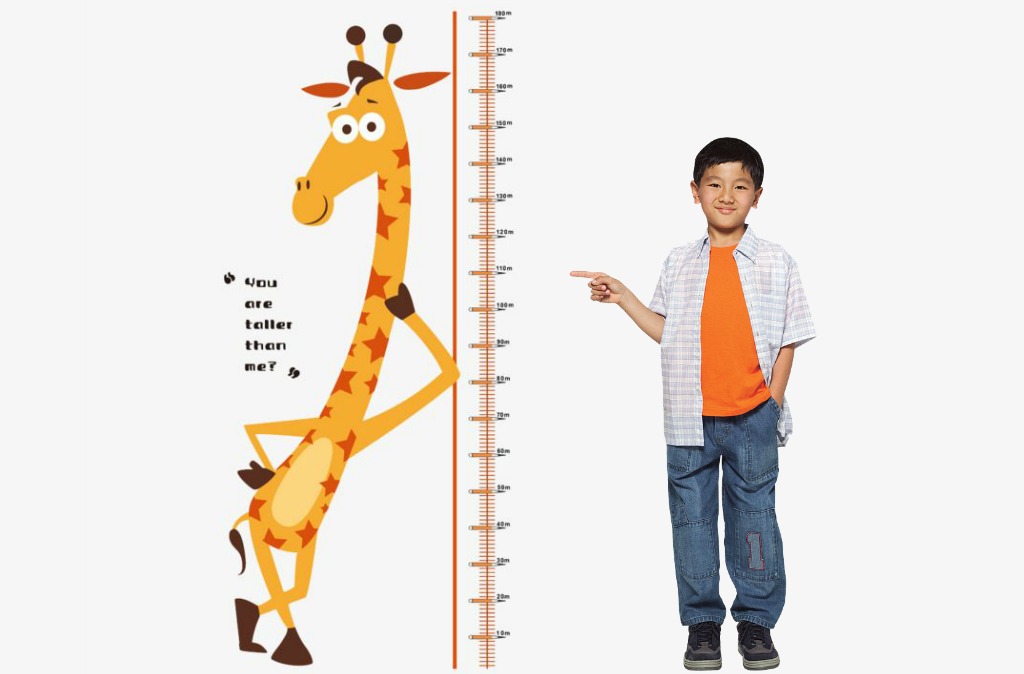There’s a popular tale going around that if you want to know your child’s adult height, you simply double his height when he is aged two and that will roughly tell you how tall he will be when he becomes an adult.
Ah, but the catchword word here is: roughly.
There is no proven method to accurately predict a child’s eventual adult height, although there are formulas (given below) to estimate.
Furthermore, a child’s eventual height is also determined by other factors, such as genetics or DNA (a child will grow to the height determined by his family’s genes), gender (boys tend to be taller than girls) and, of course, environmental factors such as nutrition, childhood illness and exercise.
Nutrition for Height
On nutrition, it is clear that a balanced diet comprising proteins, carbohydrates, fat and vitamins consumed in the correct proportion, plays a huge role in determining the trajectory of a child’s growth.
Of the many nutrients, proteins ─ which can be animal-based or plant-based ─ have been identified as the essential building blocks to growth and development because they help build muscles, bones, skin, enzymes as well as hormones in the growing child.
In fact, it has been found that a lack of protein-intake during childhood is the biggest contributing factor to stunting.
According to the National Health and Morbidity Survey (NHMS) 2019, one in five children under the age of five in Malaysia are stunted and the prevalence has increased from 16.6% (in 2011) to 21.8% (in 2019).
Stunting is not just about having a lack of height or a short stature but also carries long term consequences which Unicef says includes diminished mental ability, poor school performance, low self-esteem, poor health and so on which carries into adulthood.
Needless to say, having a child consume a protein-rich balanced diet will help him reach the height of his potential.
This doesn’t mean you load his plate up with heavy meats every day. Protein that is not burnt up is stored in the body as fat and we know that obesity is another problem affecting children in Malaysia.
So, how much protein does a child need actually? A good rule of thumb is 1 gram of protein per 1kg of body weight.
Protein is derived not just from animal meats, eggs and milk but also in vegetables and whole-grain too.
#Tip to Grow Tall
This study and WebMD says zinc helps kids grow taller. Zinc is a vital mineral for cellular growth and studies have shown that intake of this mineral may help children reach a healthy height and weight.
Zinc-rich food includes lean red meat, shellfish, nuts, seeds, beans, wholegrain cereals, breastmilk and others.
Exercise for Height
While it is clear that nutrition is vital for attaining a good height, how does exercise play a role?
Exercise or a more active lifestyle doesn’t actually make a child grow taller per se but keeping fit has always had its health benefits. It can also help him build muscle strength and strong bones.
Having said that, however, it seems there are some simple stretching exercises that can help your child elongate his spine and develop a good posture.
Even if it doesn’t literally increase his height, your child will learn to walk tall with good deportment.
Here are two exercises you can introduce to your child. You can begin as early as he can do them.
1. Stretching:
(a) With his back against a wall, make him stand on his toes and reach up as high as he can. Hold for a few seconds, then repeat. This will help him stretch his leg muscles. He can do this exercise up to 10 times a day.
(b) Another stretching exercise is to get your child to sit on the floor with his legs apart as wide as possible. Tell him to bend at the waist and stretch to touch his toes, about four times on each leg.
2. Hanging (from monkey bars)
Most playgrounds have monkey bars. Have you child grip the bars and hang or swing to and fro while the exercise strengthens the spine, arms and legs. Your child can also do chin-ups or pull-ups.
Here are 2 Methods to Predict the Height of Your Child
A. Mother & Father’s Height Average Method
- Take the mother’s height and father’s height in centimeters or inches and add them together.
- For boys, add 5 inches (13 centimeters). For girls, subtract 5 inches (13 centimeters)
- Then divide the total by two and you get the answer.
- or example: A boy’s mother is 5ft 2 inches tall (62 inches) and the father is 5ft 7inches (67 inches).
- 62+ 67=129 inches + 5 inches for boy = 134 inches divided by 2 = 67 inches.
- The boy will be estimated to be 5ft 8 inches tall, give or take 4 inches either way.
B. Height at Two Years Method
- Another way to estimate the child’s adult height is:
- Double the boy’s height at age 2, or
- Double the girl’s height at 18 months (because girls are usually shorter than boys at adulthood)
- For example: A girl is 31 inches at 18 months of age. When 31 inches is doubled, it becomes 62 inches. Therefore, the girl’s height will be around 5ft 2 inches at adulthood.
*Do note, that a child’s eventual height is largely determined by genetics plus all the other factors mentioned above such as environmental factors. Also, children grow at different rates, some children grow faster, some slower, so the above estimates will remain as estimates.
